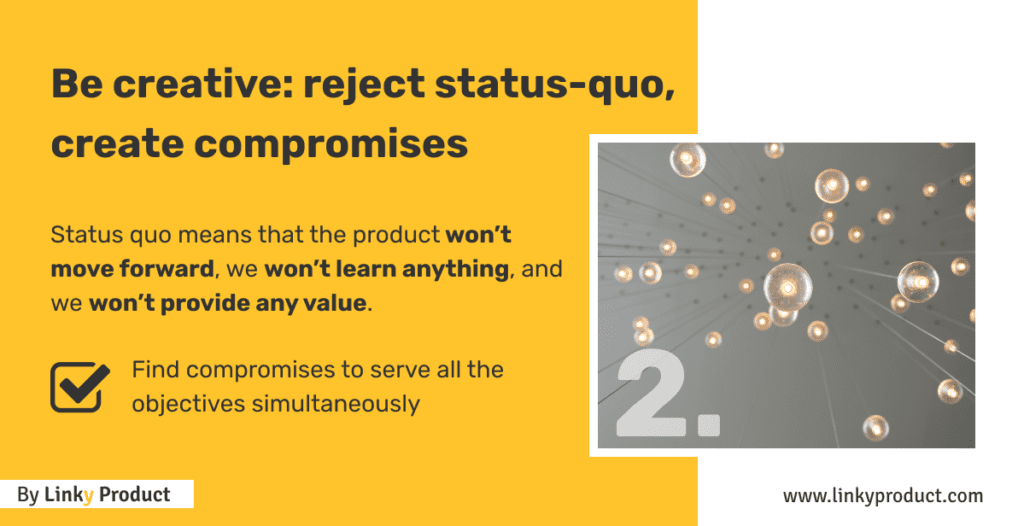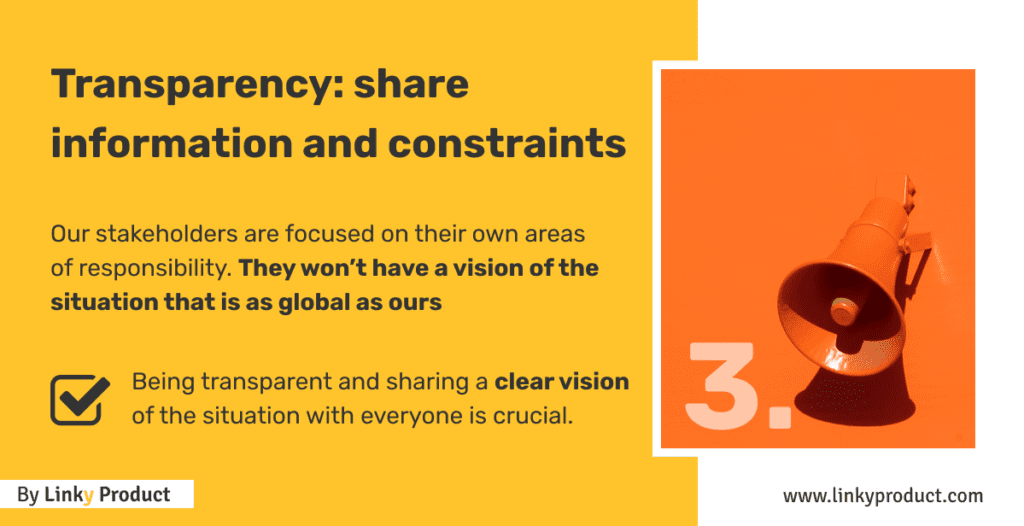Aligning stakeholders is a well-known challenge among the Product Manager community. At some point in our careers, we have all struggled with this.
Aligning stakeholders is primarily about two things: managing expectations and managing humans. There is not one specific “easy” way to be good at it. However, there exists a set of rules to make this as straightforward and pleasant as possible.
After some time, I am certain that you will enjoy these types of discussions with your peers, and that it will eventually become easier the more you practice it. Below, I will outline a couple of steps to help you along the way.
Forget the hierarchy; take the lead!

This is the advice that we have to remind ourselves of the most, as Product Managers.
The Product Manager is a leadership role. A leader’s impact is not limited to the team he/she is leading. The influence also spreads all around them, at different levels.
Not all of our stakeholders will be higher than us in the corporate hierarchy. However, in the event that they are, we should not worry about it too much nor stress over it.
Most of our stakeholders seek our advice and expect us to take the lead in the alignment process.
To align our stakeholders, Product Managers should definitely lead the way and continuously propose plausible solutions. It does not matter if they are (or aren’t) the same as those submitted by the stakeholders.
The point here is that the proposed solutions should always serve the stakeholders’ objectives!
Stakeholders that are one, two, or three levels above us in the hierarchy all behave the same: if we help them reach their objectives, they will love us.
To obtain a consensus, it is very important that we, the Product Managers, become a source of solutions.
Be creative: reject status-quo, create compromises

The status quo is the worst enemy of a Product Manager. Status quo means that the product won’t move forward, we won’t learn anything, and we won’t provide any value.
The biggest challenge we will face with a diverse group of stakeholders is that they might have very different objectives. In the most complicated cases, these objectives can be contradictory.
As a Product Manager, we will have to find compromises to serve all the objectives simultaneously. Most of the time, it’s nearly impossible to perfectly attain every objective at the same time. We cannot always find a perfect solution. “One-size-fits-all” rarely exists.
Nevertheless, we can find a solution that will serve a part of every objective. When looking for an alignment with our stakeholders, we constantly need to compromise.
We also need to understand that our stakeholders won’t propose compromises very often. They will individually defend their reasonings and objectives, which risks maintaining the status-quo for a longer time.
As Product Managers, it’s our job to find and propose these compromises. Being able to do this efficiently is key in aligning our stakeholders.
Transparency: share information and constraints

As Product Managers, we are implicated in most of the discussions. Our stakeholders are focused on their own areas of responsibility.
This means that they won’t have a vision of the situation that is as global as ours – and most of the time, they wouldn’t need to.
But when we struggle in finding alignment, being transparent and sharing a clear vision of the situation with everyone is crucial.
Let’s take an example of a real story to understand why sharing information and being transparent will help.
We have two stakeholders: one from the Support team and one from the Marketing team. The Marketing team wants to increase the number of new users by 25% during the next year. The Support team does not have any objectives related to the product, but this team is crucial in helping our clients and operating the product in the back-office.
The Marketing team is pushing hard to accomplish their ambitious go-to-market strategy and is planning numerous releases to reach their objectives.
The Support team, on the other hand, is surprisingly pushing back those ambitions, creating many frustrations within the other teams.
The key to solving this situation relies on the fact that, as a Product Manager, we are also part of the Support team’s meeting. During these meetings, we have observed that they simply don’t have enough people for the next year to support the product effectively.
Solving the problem is thus relatively simple. We can bring this important information to a subsequent stakeholder meeting, and highlight how the Support team is struggling to hire employees for a bigger team. This, in turn, will reduce the Marketing team’s frustration, since it is now aware of why the Support team was pushing back, due to the lack of resources.
We can now jump back to the previous section again, as everyone would be – at this point – in the right mindset to work together.
Use visual supports

Having a broad vision of a situation can be difficult, especially for experts who are very focused on their area of expertise.
To align everyone, it’s essential to ensure that all parties understand the whole situation. Consequently, we often have to simplify the context, remove superfluous information, and present everything in a more streamlined way.
What we found to be the most effective in this case, is to use visual presentations. We must avoid long blocks of texts at all costs!
Create diagrams, flows, boxes, and arrows… anything that does not require someone to spend 15 minutes to read a big block of text.
There are two principal benefits to using visual supports.
The first one is that it is way more fun to read a colorful slide than to skim through a long block of text. We will capture the attention of our audience, and certainly create more engagement from our stakeholders.
The second benefit is that it forces us to remove superfluous information. With a graphic presentation, we actually have to carefully select what we are going to show: the available space is limited.
Visual presentations are often a crucial part of our discussions with our stakeholders, and we must never underestimate them. Even if it’s to summarize something that was already said, or even if it appears to us to be very obvious, it’s more often than not a way to put our stakeholders on the same page and drive our discussions.
Use data and Product Management tools

Finally, and perhaps the most essential point: be sure to use data.
Everyone has ideas, gut feelings, other understandings of the situation, fears and concerns, and hopes and ambitions.
However, it’s our job as Product Managers to cipher through all of these very diverse opinions to pick the best one (hopefully).
The best way to limit the impact of opinions and gut feelings in our decisions is to rely on real, concrete data.
Valuable data can come from many different sources. Market research and user interviews are obvious sources of information.
Other tools from a Product Manager’s toolkit can also help a great deal. For example, using RICE Scoring is a way to put numbers on feelings. A RICE Score is something that we use to explain why we are prioritizing one feature over another. This RICE Score, therefore, becomes a data point.
It’s on us, the Product Managers, to rationalize the group of stakeholders’ ideas and decisions. We have to use data to solidify these decisions, ensuring that they are making sense and are ultimately reasonable and best for our product.
And if the decisions are not making sense, having data to explain “Why it does not make sense” will definitely help to entice other ideas and bring new solutions to the table.
Thank you to Olivia Rossi for the proofreading and the amazing additions to this post 🙂
